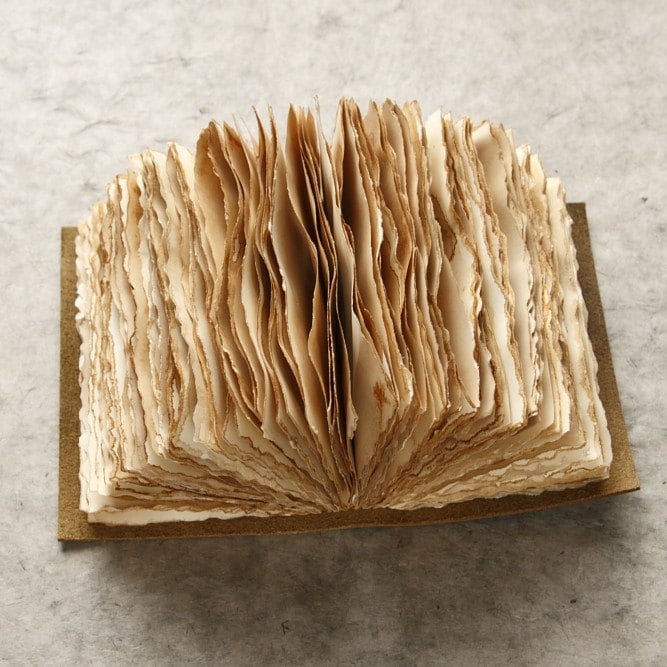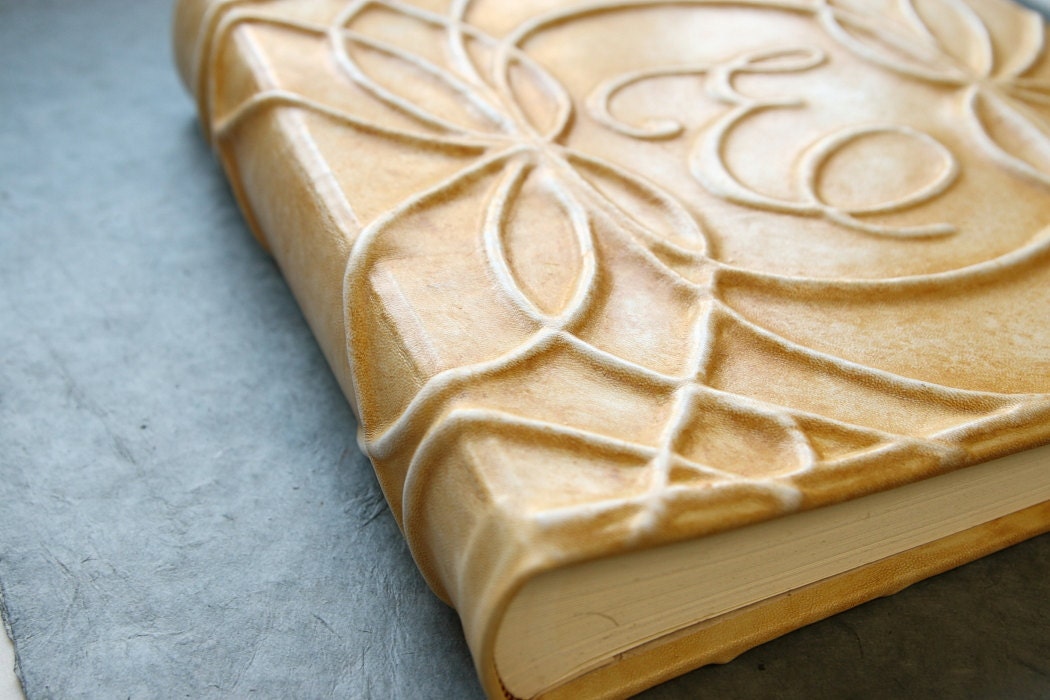When we first started making books we used a non-serated butter knife to cut paper. Seriously. Fold the paper where you want it torn/cut, and run a non-serrated butter knife inside the fold, slicing with a gentle circular sawing motion, like opening a letter with a letter opener. In fact, you could use a letter opener. This creates a nice soft edge to each page, which looks nice when a block of pages are sewn together, and helps hide the fact that your pages are not all perfectly square and lined up to each other.
Methods of cutting paper that create clean crisp cuts look a bit more uneven when all the pages are put together, because you just can't make them all perfect, and the crisp, hard edges kind of stick out. However, if you prefer, there are ways to get a flat, even surface to the edges of your text blocks after you make them, which we'll discuss briefly below.
Back when a butter knife was our way of cutting paper, Karleigh was looking for sources of paper for making pages, 1000 sheets measuring 25" x 38" (63.5 x 96.52 cm). While talking with a paper salesman on the phone, they were waiting for his pricing information to load on his computer. Here's their actual phone conversation while they were waiting:
Salesman: We usually deliver to large companies. You say you're out of your home?
Karleigh: Yes, I sell handmade books online and I just work from my home.
Salesman: What do you use to cut down all that paper?
Karleigh: I cut it at my kitchen table with a butter knife.
Salesman: (after a pause) I'll have to call you back since I don't have the prices right on hand.
He never called back. It wasn't until later that she realized how silly the butter knife response sounded.
 |
| flexible deckled and straight edge tear bar |
While a butter knife is a cheap, or free way to get started, at some point you may want to look into getting a steal tear bar.
We have two kinds, both of which we can tear five sheets of 80 lb text weight paper at a time. One is from Logan Graphic Products, has both a deckled edge and a straight edge, and is flexible. Ours is
36", but they come in at least two other sizes,
12" and
18". Some have a "bold" deckle and others a "fine" deckle. Ours is bold. The deckled edge was designed by tracing the actual natural deckled edge of a sheet of watercolor paper, so it is a much more organic design than some of the other brand of deckled edge rulers we've seen.
 |
| heavy straight edge tear bar |
The other tear bar we have is from Pacific Arc. It is a heavy, barely flexible, flat bar, with one straight edge. It's our workhorse. We find its lower flexibility is nicer to tear against than the more flexible Logan Graphic bar. Ours is
36", but they come in
18",
24",
30",
42", and
48". We'd likely prefer 30", since the papers we tear are at widest 25", and so we lug the extra 6" of weight around unnecessarily.
We think the deckled edge looks good, but it's also harder to tear. Tearing against the straight edge gives a nice soft look of its own, and that's what we usually use.
 |
| torn with straight edge tear bar |
 |
| torn with deckled edge tear bar |
 |
| handle bar cork on back |
When we bought them, both our tear bars slipped pretty easily unless putting a lot of force against them to hold them down. This made it easy to mess up a tear, and when tearing hundreds of pages it's extra hard on the hold-down-muscles. We modified both our tear bars by adhering a strip of
handle bar cork on the bottom, placing it on the edge we don't tear with. For the deckled edge bar, this made the straight edge unusable for tearing, since the cork lifts the straight edge off the surface of the paper. But, that's due to our placing the cork right on the edge. If you place it away from the edge, you could flip the bar over and still tear against the straight edge with the cork side facing up, but of course, you'll miss out on the no slip benefit of the cork tape.
 |
handle bar cork makes
tear bars no slip |
You may also use any one of a variety of
paper cutters, which, unlike a butter knife or tear bar, leaves a hard edge. Some like the look, some don't, but the edges of the final text block may be made smooth with a
commercial paper cutter, a
block plane,
plough, or even a
sander.
Anything to add to the discussion? Please leave a comment.
 We use two kinds of needles, straight and curved (we'll teach you how to make your own curved later in this post). Which one we use depends on the book structure we're working on. Curved needles work very well when sewing a coptic stitch, while a straight needle works great on a long stitch. You can make either book with either kind of needle, but we find it much easier using curved for coptic, which we find also allows for the binding to be tighter, and we find it less awkward to use straight needles on something like a longstitch.
We use two kinds of needles, straight and curved (we'll teach you how to make your own curved later in this post). Which one we use depends on the book structure we're working on. Curved needles work very well when sewing a coptic stitch, while a straight needle works great on a long stitch. You can make either book with either kind of needle, but we find it much easier using curved for coptic, which we find also allows for the binding to be tighter, and we find it less awkward to use straight needles on something like a longstitch.


































